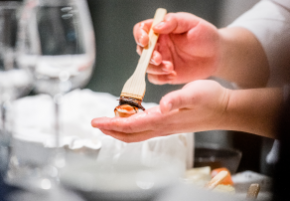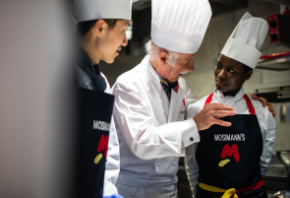- About
- Programs
- Campus Life
- Career Services
- Admissions
- News & Events
- Alumni
How to Start a Restaurant: Key Steps for Success
Discover how to start a restaurant that fits your budget and vision. Learn the essential steps to launch and grow your food business today.
Key Takeaways
- The global foodservice market hit over $3,099.66 billion (€2,865 billion) in 2023 and is expected to keep climbing in the years ahead, making now a great time to start a restaurant.
- Defining a clear restaurant concept and conducting thorough market research are essential first steps for opening a restaurant.
- Building a strong team, designing a menu that fits the concept, and promoting your restaurant effectively help set a solid foundation for long-term growth.
Thinking about opening your own restaurant? Maybe you've got a family recipe that always steals the show or a creative food concept that's been living rent-free in your mind. Either way, you're not alone. More and more people are diving into the food service world, and for good reason. The global foodservice market hit over $3,099.66 billion (€2,865 billion) in 2023 and is expected to keep climbing in the years ahead.
To learn how to start a restaurant, you need to understand what really goes into bringing one to life. From setting the foundation to creating unforgettable dining experiences, every step plays a part in turning a vision into a successful business.
How to Start a Restaurant
Opening a restaurant takes more than a great menu. It's a mix of planning, creativity, and well-timed decisions. Each step builds toward something bigger, helping shape a place people remember. Knowing where to begin can make all the difference when turning that dream into reality.
Define your restaurant concept
Step Into the World of Culinary Entrepreneurship
Learn how to lead and grow in the culinary industry
Before diving into logistics, take the time to shape the soul of your restaurant. Your concept is what brings it all together. It defines the atmosphere, the menu, the pricing, and even the uniforms. Will it be a neighborhood pasta joint with rustic charm or a sleek modern café serving plant-based meals?
Think about who you're trying to reach. Families, young professionals, tourists, and foodies all expect something different. Decide on the type of service, too, whether that's fine dining, quick service, or something in between.
One of the most important steps is making sure your vision matches your market and your budget. An elegant steakhouse might sound exciting, but if you're setting up in a student-heavy neighborhood with limited parking, it might not work. The more clearly you define your concept early on, the easier it becomes to make every decision that follows.
Conduct market research
Knowing your competition and your customers helps you build smarter, not just louder. Market research is your backstage pass into what's happening around you. It helps you uncover trends, understand demand, and see where your concept fits in.
When conducting market research, you can start by:
- Visiting local restaurants and taking notes on pricing, menu styles, and customer flow
- Reading online reviews to learn what guests like or complain about
- Running surveys on social media to gather preferences directly
- Using tools like Google Trends or hospitality reports to spot wider patterns
- Checking zoning laws and local business permits to see what's allowed where
This kind of groundwork helps avoid surprises while also revealing gaps in the market. Maybe no one is offering authentic street tacos in your area, or there's a growing demand for gluten-free bakeries. The right data can point you in a direction that is both exciting and financially viable. Investing in research early on saves time, money, and frustration down the road.
Write a business plan
Think of your business plan as the heartbeat of your restaurant. It connects all your ideas and gives them structure. More than a document for investors, it keeps you focused as things start moving fast.
A solid business plan typically includes:
- An executive summary to describe your mission and concept
- A detailed menu overview and pricing strategy
- A competitive analysis to show how you'll stand out
- A marketing plan to explain how you'll reach your audience
- An operational plan covering suppliers, staffing, and daily tasks
- Financial projections showing expenses, revenue forecasts, and funding needs
This plan is what will help you communicate your dream to banks, partners, and even your own team. At Culinary Arts Academy Switzerland (CAAS), students are taught how to craft business plans that are not only thorough but grounded in real-world insight. It's not just about big ideas. It's about making sure those ideas are viable, clear, and ready to be put into motion.
Secure funding
A great idea needs fuel to become a reality—and that fuel is funding. From leasing your space and renovating interiors to hiring staff and stocking the kitchen, startup costs add up quickly.
The first step is figuring out exactly how much you need. Be realistic, and build in a buffer for unexpected expenses. Once you have a number in mind, explore different funding options:
- Personal savings can offer flexibility, but you don't want to drain your safety net
- Business loans through banks or credit unions are common for startups
- Angel investors may be open to funding if your concept is unique and promising
- Crowdfunding platforms work well if you can build a community around your brand
Register your business and get licenses
Now that the foundation is in place, it is time to make your business official. While the specifics vary by location, most restaurant owners will need to complete several key steps. First, you will need to choose a legal structure. Many small restaurants operate as LLCs for tax and liability reasons, but sole proprietorships and corporations are also options.
After that, register your business name with the appropriate local or national authorities. You will also need an EIN from the tax office so you can hire staff and handle payroll.
Next comes licensing. This includes food service permits, health department approvals, and safety inspections. If you plan to serve alcohol, a liquor license is a must. You might also need fire safety certifications and signage permits, depending on your location. It may not be the most creative part of the journey, but legal compliance is what turns your dream into a legitimate, functioning business.
Choose a location and lease the space
Your location is more than a pin on the map. It plays a major role in your restaurant's success. You want a space that matches your concept and attracts the right kind of foot traffic.
A fine dining spot tucked behind a parking lot probably won't see the kind of buzz it deserves, while a food truck in a busy business district might thrive at lunchtime. Look for places with favorable demographics, good visibility, and easy access. Spend time walking the neighborhood, talking to locals, and observing the flow of people.
Once you've found the right space, review the lease carefully. Take your time reading the terms. Pay attention to rent increases, length of lease, and what expenses are covered. Negotiating lease terms might seem intimidating, but small adjustments can make a big difference down the line.
Build your team and source equipment
Behind every successful restaurant is a great team. Your chefs, servers, and managers will be the face of your concept, so choose wisely. Look for people who not only have the right skills but also share your passion and values.
A strong cultural fit leads to smoother operations, better guest experiences, and a more unified brand. Invest in strong onboarding and create an environment where your team feels respected and supported.
At the same time, begin sourcing your equipment. Prioritize essential kitchen gear that matches your menu needs. For example, skip trendy gadgets you're unlikely to use. Choose reliable suppliers for stoves, refrigerators, and prep stations.
Furniture and lighting are essential in expressing your restaurant’s concept. The right design choices create an atmosphere that not only reflects your brand but also makes guests feel comfortable enough to linger, return, and recommend.
Equally important is investing in a reliable point-of-sale (POS) system. This isn’t just about processing payments; it’s about ensuring smooth operations and protecting your revenue. A POS system that frequently crashes frustrates customers and undermines your credibility. In a fast-paced food service environment, these technical foundations are as critical as the food itself.
Design your menu and set prices
Your restaurant menu is your story told through food. It shapes expectations and defines your guest experience. Whether you're serving bold, modern fusion or traditional comfort food, every item should support your concept.
Keep your menu manageable and well-balanced, both in variety and kitchen execution. When pricing, you want to be profitable without scaring away your target market. Consider food cost control, portion sizes, kitchen capabilities, and pricing psychology when building your list.
At CAAS, culinary students learn this balance firsthand while creating seasonal menus at Restaurant Alpina in Brig. They discover how to work with local ingredients, adapt to changing seasons, and develop offerings that feel both innovative and approachable.
This kind of hands-on training is what brings a menu to life. When your food, pricing, and concept align, your restaurant feels purposeful and connected.
Promote your restaurant
Even the best food in town needs a little spotlight. Promotion is about creating excitement and giving people a reason to walk through your doors. Start with the essentials: a clean, mobile-friendly website with your menu, location, and contact info.
Claim and update your Google Business profile so customers can find and review you easily. Build a presence on platforms like Instagram and Facebook, where you can share photos, behind-the-scenes moments, staff features, and dish highlights.
Local advertising, partnerships with nearby businesses, and collaborations with influencers or bloggers can help you expand your reach. When it's time to open, consider a soft launch with friends and family or a preview night for media and neighbors.
These smaller events help you test operations and generate word of mouth. Marketing needs to be consistent, authentic, and aligned with the experience you're creating. So, let your passion come through in everything you share.
Tips for Long-Term Success
Running a restaurant is about staying relevant, profitable, and genuinely appreciated over time. Long-term success comes from daily discipline, smart decisions, and deep care for both your guests and your team. Here are some practical tips to help you thrive well beyond opening week:
- Keep customer service a priority. Friendly, attentive interactions give guests a reason to return and tell others.
- Maintain consistent food quality through regular staff training and quality checks.
- Collect guest feedback through comment cards, online reviews, or short surveys and use it to improve.
- Invest in your team by offering clear growth paths, fair pay, and a positive work culture.
- Use tools like POS analytics or accounting software to track sales, costs, and profit margins regularly.
- Stay updated on local regulations and keep licenses, safety checks, and hygiene standards in good standing.
- Rotate your menu seasonally or introduce specials to keep things fresh and exciting.
- Build loyalty with promotions, events, or membership perks that reward repeat guests.
Types of Restaurants You Can Start Today
When exploring how to start a restaurant, one of the first major decisions is choosing the type of dining experience you want to offer. Your choice should reflect your budget, lifestyle, and the kind of vibe you want to create. A few popular options to consider include:
- Food truck: Great for lower startup costs and mobility. Ideal if you want to test a concept or bring your food directly to where the crowds are.
- Café: A cozy option for serving coffee, baked goods, or light meals. Works especially well in community-focused neighborhoods or near schools and offices.
- Ghost kitchen: A delivery-only model with no dine-in space. Perfect if you want to focus entirely on online orders and save on overhead costs.
- Casual dining: Offers a laid-back atmosphere with sit-down service. Well-suited for family-style meals or neighborhood restaurants with a loyal following.
- Fine dining: A high-investment model focused on exceptional service, ambiance, and gourmet food. Best for experienced restaurateurs with a clear vision.
- Pop-up restaurant: A short-term setup that allows you to build buzz or test a menu. Often used by chefs looking to experiment creatively.
Your Restaurant Journey Starts Here
Starting a restaurant might seem overwhelming at first, but with a clear concept, solid planning, and the right mindset, it's absolutely within reach. Every beloved restaurant began with a spark of an idea and the courage to bring it to life. From picking the perfect location to building a team and designing your menu, each step lays the foundation for something truly special.
Yes, it takes work, but the reward of seeing your vision come alive is worth it. At Culinary Arts Academy Switzerland (CAAS), our programs are designed to help aspiring restaurateurs like you gain the hands-on experience and business skills needed to succeed. So take that first step, trust the process, and who knows, your restaurant could be the next local favorite!
Frequently Asked Questions (FAQs)
How much does it cost to start a restaurant?
The cost to start a restaurant can vary widely depending on the type, size, and location of your business. However, to give an idea, one survey estimated that the average startup cost for a restaurant is $375,500.
What is the most important thing to keep in mind when opening a restaurant?
The most important thing is to have a clear concept that meets market demand and solid financial planning.
What staffing roles are essential before opening day?
Some essential staffing roles before opening include a head chef, kitchen staff, servers, and a restaurant manager.
Interested in studying at CAAS? Download our brochure to learn about our programs!



























